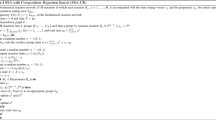Abstract
It is well known that firings of a well-stirred chemically reacting system can be described by a continuous-time Markov chain. The currently-used exact implementations of Gillespie’s algorithm simulate every reaction event individually and thus the computational cost is inevitably high. In this paper, we present an exact implementation of a continuous-time Markov chain with bounded intensity which can simulate the process at given time points. The implementation involves rejection sampling, with a trajectory either accepted or rejected based on just a few reaction events. A simulation study on the Schlögl model is presented and supplementary materials for this article are available online.


Similar content being viewed by others
References
Arkin A, Ross J, McAdams H (1998) Stochastic kinetic analysis of developmental pathway bifurcation in phage \(\lambda \)-infected E. Coli cells. Genetics 149:1633–1648
Beskos A, Papaspiliopoulos O, Roberts GO, Fearnhead P (2006) Exact and computationally efficient likelihood-based estimation for discretely observed diffusion processes. J R Stat Soc B 68(3):333–382
Beskos A, Roberts GO (2005) Exact simulation of diffusions. Ann Appl Probab 15(4):2422–2444
Cao Y, Gillespie D, Petzold L (2006) Efficient step size selection for the tau-leaping method. J Chem Phys 124:044109
Elliott RJ (1982) Stochastic calculus and applications. Springer, New York
Elliott RJ, Chen Z, Duan Q (2009) Insurance claims modulated by a hidden Brownian marked point process. Insur Math Econ 45:163–172
Higham DJ (2008) Modeling and simulating chemical reactions. SIAM Rev 50:347–368
Gillespie D (1976) A general method for numerically simulating the stochastic time evolution of coupled chemical reactions. J Comput Phys 22:403–434
Gonçalves F, Roberts GO (2013) Exact simulation problems for jump diffusions. Methodol Comput Appl Probab. doi:10.1007/s11009-013-9330-2
Pahle J (2009) Biochemical simulations: stochastic, approximate stochastic and hybrid approaches. Brief Bioinform 10(1):53–64
Pu Y, Watson LT, Cao Y (2011) Stiffness detection and reduction in discrete stochastic simulation of biochemical systems. J Chem Phys 134:054105
Ross SM (2007) Introdution to probability models, 9th edn. Elsevier, Singapore
Sehl M, Zhou H, Sinsheimer JS, Lange KL (2011) Extinction models for cancer stem cell therapy. Math Biosci 234(2):132–146
Acknowledgments
We are indebted to two anonymous referees and an associate editor. Their comments and suggestions were extremely useful in improving the article, and they rewrote parts of the paper.
Author information
Authors and Affiliations
Corresponding author
Rights and permissions
About this article
Cite this article
Duan, Q., Liu, J. A first step to implement Gillespie’s algorithm with rejection sampling. Stat Methods Appl 24, 85–95 (2015). https://doi.org/10.1007/s10260-014-0283-6
Accepted:
Published:
Issue Date:
DOI: https://doi.org/10.1007/s10260-014-0283-6




